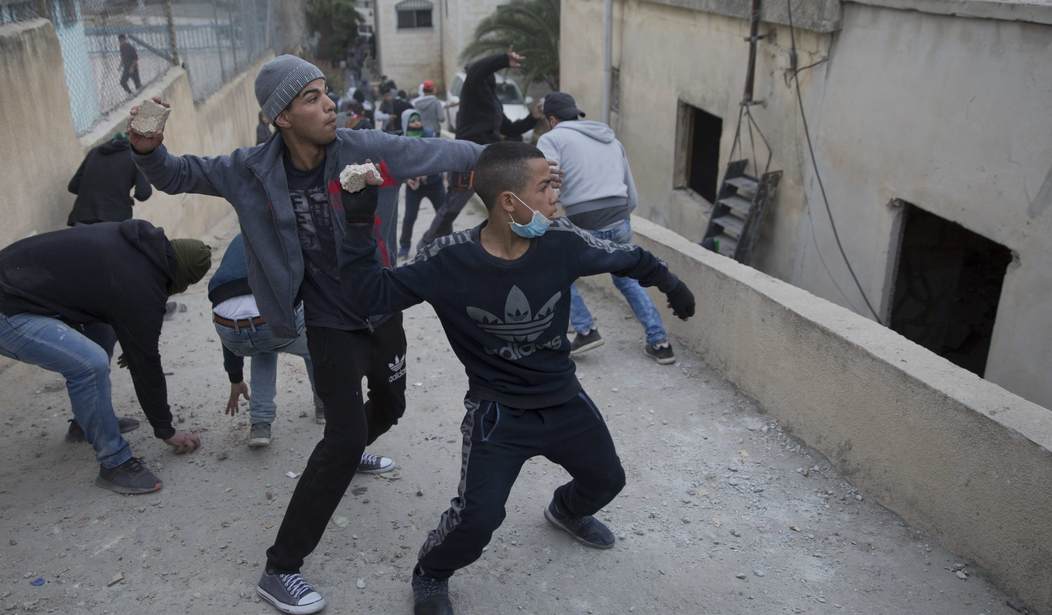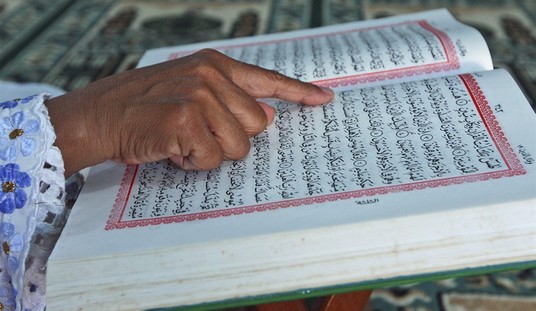“West Bank grows calmer as pocketbook issues take priority of protests” is the headline of a New York Times story today. It seems that the Palestinian jihadists of the old intifadas are more concerned about making a living than killing Israelis. Writes reporters Isabel Kershner:
BILIN, West Bank — On a recent weekday, Muhammad Abu Rahma returned to the place where Palestinian protesters and Israeli soldiers used to clash in weekly confrontations that made the West Bank village of Bilin a symbol of resistance against the Israeli occupation.
But this time, he came not to protest but to picnic with his wife and three children. He had served three terms in prison for his activities at the height of the protests. But now, at 33, he had a family and a job as a garbage collector.
“People want money to live, and permits,” he said, referring to the Israeli permits allowing laborers to work in Israel, where they can earn twice as much as they do in the Palestinian territories.
It turns out that time is on Israel’s side, as Ambassador Yoram Ettinger and other Israeli analysts have argued for years. The Arab “demographic time bomb” turned out to be a dud, as fertility rates plunge across the Muslim world, a phenomenon I discussed in my 2011 book How Civilizations Die. In a 2011 analysis for Asia Times, I counseled Israel not to attempt to make peace with a Palestinian population heavily tilted towards hot-headed youngsters, and to wait until the declining Palestinian fertility rate had raised the average age of the West Bank population. Like Northern Ireland, the militants would find themselves married with mortgages (at least those who survived). Prime Minister Netanyahu generously commented on the article when it was published.
Although the aging kleptocrats who still run the Palestine Authority out of Ramallah won’t admit it, the time is ripe for the kind of peace plan that the Trump administration offered at last month’s Bahrain conference. Drafted under the direction of presidential adviser Jared Kushner, the plan would channel $50 billion in development aid to the West Bank over a ten-year period. Israeli observers note that despite the PA’s intransigence, the administration plan has shifted the debate in the Middle East and isolated the Palestinian jihadists.
By way of background, I repost below my 2011 analysis. President Trump and Prime Minister Netanyahu are doing precisely the right thing.
Israel, Ireland, and the Peace of the Aging (from Asia Times, June 2011)
by Spengler
Sometimes, the best thing to do is nothing at all.
A generation from now, the Palestinians will make peace with Israel, for a simple reason: they will grow up–literally. Palestinian Arabs comprise one of the fastest-aging populations in the word.
Barack Obama was misinformed when he told the America-Israel Political Action Committee May 22 that “the number of Palestinians living west of the Jordan River is growing rapidly and fundamentally reshaping the demographic realities of both Israel and the Palestinian territories.” In fact, Palestinian fertility on the West Bank has already converged on the Israeli fertility rate of three children per woman, if we believe the Palestine Ministry of Health rather than the Palestine Authority’s statistics bureau.
There is endless debate about the Palestinian population numbers. Israel’s peace party has advanced the “demographic argument” for years, and has been consistently wrong. The decisive data point is that Palestinian Arab fertility has plunged and, in consequence, the Arab population will age rapidly. That augurs well for peace, a generation from now. After three-quarters of a century of warfare, starting with the 1937 Arab uprising against British rule in Palestine, it’s not a hardship to wait one more generation.
In this regard, the Northern Ireland peace agreement of 1998 is worth revisiting. At the Obama White House, the Irish sense of victimhood blends easily with the president’s own anti-colonial resentment, and the Third World sympathies of such advisors as the Iranian-born Valerie Jarrett. Ireland has been the White House template for a “peace process,” which is why Obama brought in as chief negotiator former Senator Mitchell, who negotiated the Irish settlement in 1998. Samantha Power, Obama’s foreign policy aid in the Senate and now head of the National Security Council’s human rights desk, figures prominently in the President’s inner council. Born in Dublin, Power brings the sensibility of post-Catholic Ireland to international affairs: sensitivity to minority rights, horror at violence, and an urge to wield military power on behalf of beleaguered ethnic groups.
Ms. Power persuaded the president to intervene in Libya to save civilian lives, perhaps the silliest and least successful use of American arms since the founding of the republic. Like Ireland’s President Mary Robinson, the former human rights chief at the United Nations whom Obama gave the Presidential Medal of Freedom, Power identifies the Palestinians with the Catholic Irish, as a putative victim oppressed by a colonial power.
Leave aside the obvious differences (for example, every Catholic cleric of standing denounced IRA terrorism, while plenty of prominent Muslim clerics endorse suicide bombing). Time heals some wounds. Northern Ireland’s guerilla war between the Protestant majority and the Catholic minority ended in 1998 for a number of reasons. Prominent among them was the simple fact that the hell-raising youngsters of the 1970s had become middle-aged fellows with jobs and families. Former Senator George Mitchell negotiated the “Good Friday” agreement that effectively ended the conflict. But he resigned in frustration last month as President Obama’s negotiator in the Middle East.
As a student journalist, I travelled in Northern Ireland in 1970, gulping improbable quantities of Guinness with Catholic radicals in Londonderry and Belfast. Everyone was young, and everyone was mad. I watched the Protestants’ Orange Order march on July 12, the anniversary of the Battle of the Boyne in 1692 that finished off Irish resistance. I joined a busload of protesters off to demonstrate at Armagh Prison in support of Bernadette Devlin, then the heroine of the nationalist cause. The Ulster Defense Regiment stopped us at a roadblock, waved us out of the bus, and stuck submachine guns in our ribs. “Don’t worry,” said the fellow next to me. “They don’t have any bullets.” The protesters sang the theme song to “Dad’s Army” (a British comedy about the elderly Home Guard of World War II) and jeered at the Protestant cops. We were drunk, and they were drunk. It’s surprising more people weren’t killed. No-one was sober enough to care. The young IRA types I met didn’t want peace. They wanted to raise hell and they held their lives cheap.
By the time George Mitchell came around to mediate in 1998, the hell-raisers of 1970, or what was left of them, had families and gave some thought to how to pay a mortgage. Prison and bullets had winnowed the ranks of the hard core.
Distribution of Irish Population by Age Group, 1970 vs. 2010
Source: United Nations Population Division
Ireland’s population was front-loaded into the teens and twenties back in 1970, when the troubles were at their worst. By 1998, the bulge in the population distribution had moved into the thirty-to-forty-year bracket. The Irish got older, and got tired of killing.
Something like this well may occur in the Palestinian territories over the next generation. The data shown above for Ireland are quite accurate; Palestinian demographic data are notoriously unreliable, for the Palestine Authority records more phantom aid recipients than ever the Cook County Democratic Party recorded phantom voters. According to an authoritative study by the Begin-Sadat Center for Strategic Studies, the West Bank and Gaza population in 2004 was only 2.5 million, rather than the 3.8 million claimed by the Palestinian authorities. The numbers are inflated to increase foreign aid and exaggerate the importance of the Palestinian population. The Begin-Sadat Center observes,
[The Palestine Central Bureau of Statistics] projected that the number of births in the Territories would total almost 908,000 for the seven-year period from 1997 to 2003. Yet, the actual number of births documented by the PA Ministry of Health for the same period was significantly lower at 699,000, or 238,000 fewer births than had been forecast by the PCBS… The size of the discrepancy accelerated over time. Whereas the PCBS predicted there would be over 143,000 births in 2003, the PA Ministry of Health reported only 102,000 births, which pointed to a PCBS forecast 40% beyond actual results.
The UN data are adopted without revision from the Palestinian statistics bureau, which inflates birth data by 25% to 40%, and also counts hundreds of thousands of Palestinians living abroad as if they were still residents. It is clear that the overall population estimates are much too high—perhaps by 1 million of the supposed 3.5 million total—but less clear how much of the overestimate is assigned to each age bracket.
Palestinian Fertility, Report by Statistics Bureau vs. Palestine Ministry of Health
Sources: UN Population Division, Begin-Sadat Center
Bearing in mind that the data are unreliable, the age distribution chart below is nonetheless indicative.
Distribution of Population in Palestinian Territories by Age Group, 2010 vs. 2040 (Projected)
Source: United Nations Population Division
Around 80,000 Palestinian men are employed by one or another of the “security forces” in Gaza and the West Bank. The Palestine Authority’s grossly inflated numbers claim that there were 587,000 men aged 20 to 40 in the territories; the actual number is probably around 400,000, which means that one in five has a job carrying a gun. Taking unemployment into account, that implies that one in three Palestinian men with a full-time job is a gunman.
That may change over time. 5,800 Palestinians are working at technology companies on the West Bank, and the booming Israeli software sector is outsourcing to the West Bank, with a third of Palestinian software companies filling orders for Israeli firms, Bloomberg News reported March 15. And the top school for Palestinian computer science students is Ariel University in Samaria, in the midst of a settlement near Nablus. “Administrators at the Ariel University Center are proud to have the Arab students, saying their enrollment is an example of loyalty and equality among Israeli citizens. For their part, the Arab students seem not to feel uncomfortable attending the college despite its reputation and location,” wrote the Chronicle of Higher Education. “On campus the fact that we are in occupied territory is irrelevant—it doesn’t affect us at all. We leave all the politics outside,” the Chronicle quoted Manar Dewany, a 20-year-old student in math and computer science who commutes each day from the Israeli Arab town of Taybeh. “I never even considered it a reason for not coming here,” Ms. Dewany added. “I have no problem with it. Why not come here? This place is full of Arabs.”
No-one outsources computer technology to Egypt, where very few of each year’s crop of 700,000 college graduates meets world standards. The education that young Arabs receive at the settlers’ university on the West Bank is better than anything available among Israel’s Arab neighbors. In a quiet way, the settlers of Samaria may do more for peace than the diplomats.
By 2040, the stone-throwing kids of the First Intifada will be close to retirement age, and the gun-toting young men who dominate today’s Palestinian employment picture (or those who still are alive) will have families. If they missed out on high-tech jobs, the spillover from the West Bank’s economic growth—driven in turn by Israel’s economic miracle—will keep them employed in service industries. Absent additional violence, the West Bank will flourish while Egypt and Syria descend into penury and chaos.
There is no urgency to make peace, except in the minds of the Palestinians’ present leaders. The world has allowed them to rule a little fiefdom as warlords of private armies, with little accounting for billions in foreign aid, and the opportunity to indulge in a grand ideological tantrum on the tab of Western donors.
The window is closing for radical Islam. That makes the present an exceptionally dangerous period, because the radicals know that it is closing. Contrary to what Obama said on May 22, the radicals understand better than anyone else that time and demographics are against them. The Palestinians of the West Bank are better off than any other Arabs in the region by any tangible measure—health, literacy, higher education, per capital income. They have the good luck to reside next to one of the world’s most dynamic economies. In a generation the world may have moved beyond the likes of Mahmoud Abbas. That gives Abbas an incentive to gamble while he still has chips on the table. If the radicals can be contained through the present generation, though, they can be extirpated in the next.













Join the conversation as a VIP Member